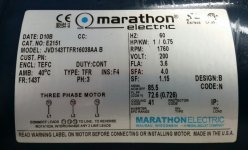Hi, I am new to VFD's and despite all of my reading before buying items I think I overlooked the voltage on the motor I bought and not sure if it will be OK.
I have 220 single phase in my shop, measured with a meter it is around 245v. I bought a Teco FM50 VFD, this one here
1 HP TECO VFD 23� VAC 1PH INPUT 3PH OUTPUT
The motor I bought is a Marathon 143TTFR16038 1HP motor but I didnt realize it was 200v instead of 208-230v.
This is the motor I bought.
MARATHON 1 HP 18�� RPM TEFC 2�� VOLTS 143T 3 PHASE MOTOR NEW SURPLUS | eBay
Will this motor be OK running it thru that VFD? From what I have gathered as long as its not run at full speed for long periods it may be OK?
I am using it to convert my tabletop Milling machine.
Thanks for any info.

I have 220 single phase in my shop, measured with a meter it is around 245v. I bought a Teco FM50 VFD, this one here
1 HP TECO VFD 23� VAC 1PH INPUT 3PH OUTPUT
The motor I bought is a Marathon 143TTFR16038 1HP motor but I didnt realize it was 200v instead of 208-230v.
This is the motor I bought.
MARATHON 1 HP 18�� RPM TEFC 2�� VOLTS 143T 3 PHASE MOTOR NEW SURPLUS | eBay
Will this motor be OK running it thru that VFD? From what I have gathered as long as its not run at full speed for long periods it may be OK?
I am using it to convert my tabletop Milling machine.
Thanks for any info.





